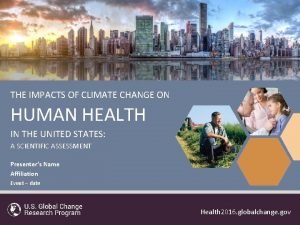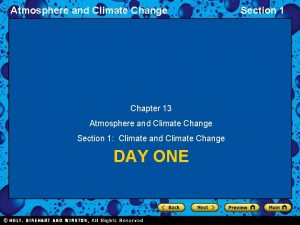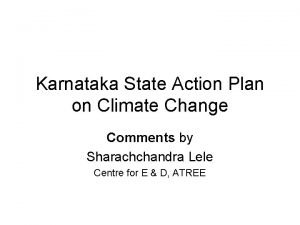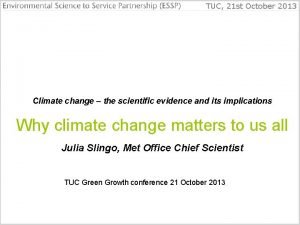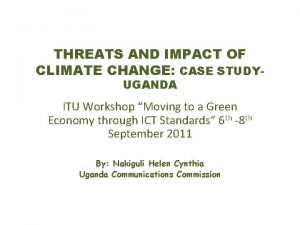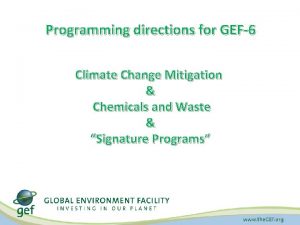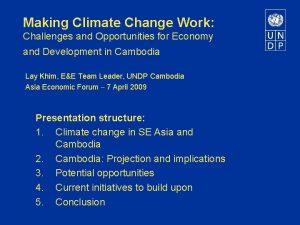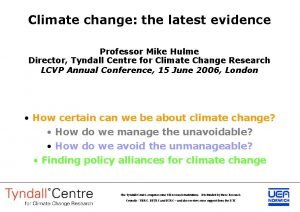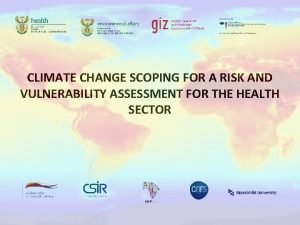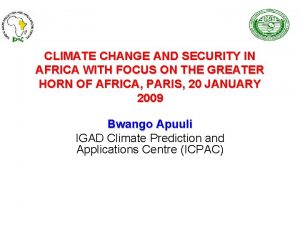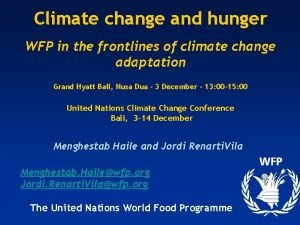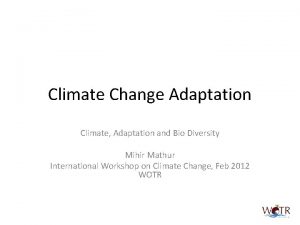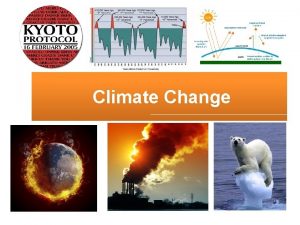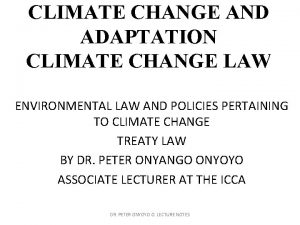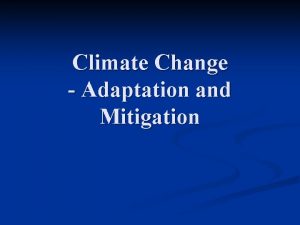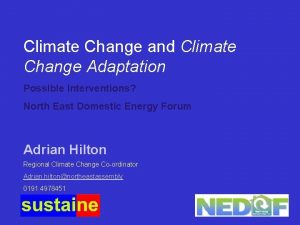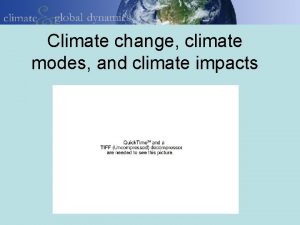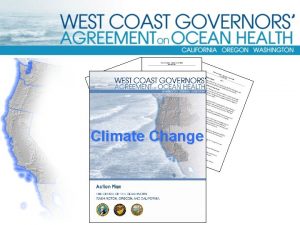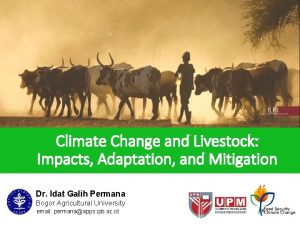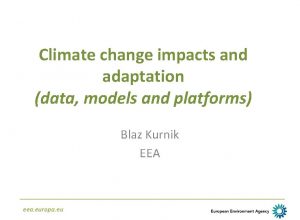Climate Change in China Impacts and adaptation DefraDFID
























- Slides: 24

Climate Change in China: Impacts and adaptation Defra-DFID China-UK collaboration Reading July 29 th, 2008 Prof Lin Erda lined@ami. ac. cn Chinese Academy of Agricultural Sciences Declan Conway, UEA d. conway@uea. ac. uk

Achievements in Phase I (2001 -04) Climate Change Scenarios Temperature to increase by 3~4℃ and rainfall to increase 10~12% by 2080 s 2 2. 5 3 3. 5 4 4. 5 5 5. 5 Crop Yield Changes Yields of rice, maize and wheat to change significantly in the next 80 years - without any adaptations

Phase II (2005 -08) Aims: ¡Improvements to national modeling of climate impacts ¡Ningxia case study: Integrated assessment for adaptation policy making

New results from Phase II Integrating climate change, water availability and socio-economic scenarios ¡Climate Change; ¡CO 2 fertilization effects; ¡Water Availability; ¡Agricultural land conversion; ¡All drivers together

CLIMATE SCENARIOS T, P, R EFFECTS OF CO 2 SOCIO-ECONOMIC SCENARIOS No, A 2, B 2 GDP, Pop. , Water demand, Land use IMPACTS ON TOTAL PRODUCTION ADAPTATION POLICIES IMPACTS ON CROP YIELDS, WATER AVAILABILITY, AND ARABLE LAND Improvements in Agric. Tech. Land use change policies Water allocation policies

– Annual change in temperature and rainfall for China: 2020 s, 2050 s, and 2080 s – 17 GCMs from IPCC and PRECIS (A 2 emissions)


Change in total cereal production with different combinations of drivers Climate Change With CO 2 Only Climate Change With CO 2 and water Climate Change All drivers Climate Change

Changes in cereal production per capita under combinations of drivers

The effect of adaptation strategies on cereal production per capita

China Case Study: Regional Impacts, Vulnerability and Adaptation Chinese Academy of Agricultural Sciences – Institute of Environment and Sustainable Development in Agriculture Ningxia CDM service centre Ningxia Meteorological Bureau Prof Lin Erda lined@ami. ac. cn Chinese Academy of Agricultural Sciences Declan Conway, UEA d. conway@uea. ac. uk

Ningxia Autonomous Region – north-west China Semi-arid to arid – high levels of rural poverty Range of different farming systems

Ningxia regional Integrated Assessment – objectives ¡ Research impacts and vulnerability in the agricultural sector ¡ To help develop the capacity to plan for and respond to a changing climate in China and Ningxia ¡ Design a regional adaptation framework and strategy for Ningxia ¡ Awareness raising, dissemination and engagement

Adaptation guidelines for Ningxia ¡ Technical report ¡ User-friendly report for decision-makers consisting of three separate sections 1. Short presentation of an ‘adaptation framework’ 2. Explanation of how to apply the framework, experience from Ningxia 3. An example of an adaptation strategy for the agricultural sector in Ningxia

An adaptation framework for Ningxia Working with UKCIP New knowledge/ research 1 Assess climate risks Adaptation as a process 2 Integrate development and adaptation goals 3 Identify adaptation options 6 Monitoring and evaluation 5 Implementation 4 Prioritise options

Table 1. Recent climate variability and extremes in Ningxia Climate factor Evidence of local impacts Recent warming: Minimum and maximum temperatures have warmed, particularly since the 1980 s Positive impacts include winter wheat has migration northward, harvest time has increased, frost free days have increased, and cold and frost disasters have decreased. Rainfall: long-term variability has been fairly modest and is similar across the whole region. [Some larger monthly and subregional trends] Of all three agro-ecosystems surveyed, drought is the most recognized meteorological disaster, especially in the middle arid area and southern rainfed mountainous area. Most respondents in the middle arid area believe that it has become increasingly difficult to acquire drinking water. Major drought 2004 -06: Observations and local experience support an increased Rainfall lowest on record frequency and intensity of droughts with negative impacts in some areas on livelihoods. Crop failure experienced in some areas, significant economic impacts, especially in central area Some farmers, who depend on rainwater collection cellars, have to buy water in the drought period.

Rural livelihoods and vulnerability to climate hazards in Ningxia Questionnaires and discussions with farmers

Table 2. Future climate change and key risks and opportunities in Ningxia Climate factor Main effects, short and long term Confidence in scenario Continued warming, e. g. max temperatures increase with B 2 and A 2; 2020 s 1. 6, 1. 8°C 2050 s 2. 6, 3. 6°C Benefits from longer growing season Possible negative impacts of extreme temperatures on yield Change in frequency and distribution of pests and disease High confidence, all models show warming at fairly similar rates Medium confidence in secondary impacts (CO 2 fertilisation critical) Rainfall trends: moderate increase overall (drier in summer, wetter in spring); 2020 s +3%, +5% 2050 s +4%, +8% Moderate impacts on water availability and soil moisture. Impacts will depend on seasonal timing of changes High-medium confidence, all models show increase in rainfall but seasonal changes less clear

High-level adaptation recommendations for agriculture and prioritisation ¡ Consider establishment of a cross- departmental group on adaptation within regional government ¡ Raising awareness on climate change trends, potential impacts and adaptation activities across the region

Table 6. Examples of priority adaptations Sector / Risk or Risk opportunity priority Possible high level adaptations Respon- Adapt. sible priority stakeholder(s) Northern Ningxia RISK: Change in Yellow River flows Improvements in early warning Improvements in High intra-regional (and sectoral) allocation of water Yellow River Comm. Ningxia Water Resource Dept. High

Some reflections on Phase II Challenges: Uncertainty about the detail of CC remains high – need for research to reduce uncertainties flexibility / adaptive management Climate science Time scales beyond/ horizons of stakeholders Seasonal forecasting Decadal variability (causes of droughts) Other socio-economic changes more significant (population, growth) Improved understanding of economic CO 2 -crop water useland cover interactions Modelling impacts can become very complex Better of extremes (projections andunderstanding time consuming (CO 2 fertilisation, model and sensitivity, impacts) etc. )

Some reflections on Phase II Methods: Consultation essential – need good understanding of current sensitivity, vulnerability and capacity to adapt Impacts assessment – can be very technical/time consuming – keep simple Embed CC concerns within existing management systems and processes No blueprints for adaptation, need to invest time on communication and awareness raising, especially at provincial level

Some reflections on Phase II Opportunities: Recent extremes may highlight current sensitivity and vulnerability (and effective responses) Concern about CC may be quite high Many existing options often already present – ‘no regrets’ [CC often exacerbates existing problems] Entry points likely to be dealing with existing ‘adaptation gap’: better management of climate hazards

Thank you
 Climate change 2014 mitigation of climate change
Climate change 2014 mitigation of climate change Impacts of climate change
Impacts of climate change Climate change meaning
Climate change meaning Atmosphere
Atmosphere Chapter 13 atmosphere and climate change
Chapter 13 atmosphere and climate change Climate change paragraph
Climate change paragraph Karnataka state action plan on climate change
Karnataka state action plan on climate change Brainpop climate types
Brainpop climate types Unit 9 climate change
Unit 9 climate change Conclusion of climate change
Conclusion of climate change Conclusion of climate change
Conclusion of climate change Conclusion of climate change
Conclusion of climate change Mathematics of climate change
Mathematics of climate change Climate change definition ap world history
Climate change definition ap world history Climate change mitigation
Climate change mitigation Pc 414
Pc 414 Conclusion of climate change
Conclusion of climate change Factors of climate change
Factors of climate change Human causes of climate change
Human causes of climate change Framework sample
Framework sample Uk climate change
Uk climate change Climate change interview
Climate change interview Factors affecting global warming
Factors affecting global warming Conclusion of climate change
Conclusion of climate change Conclusion of climate change
Conclusion of climate change

